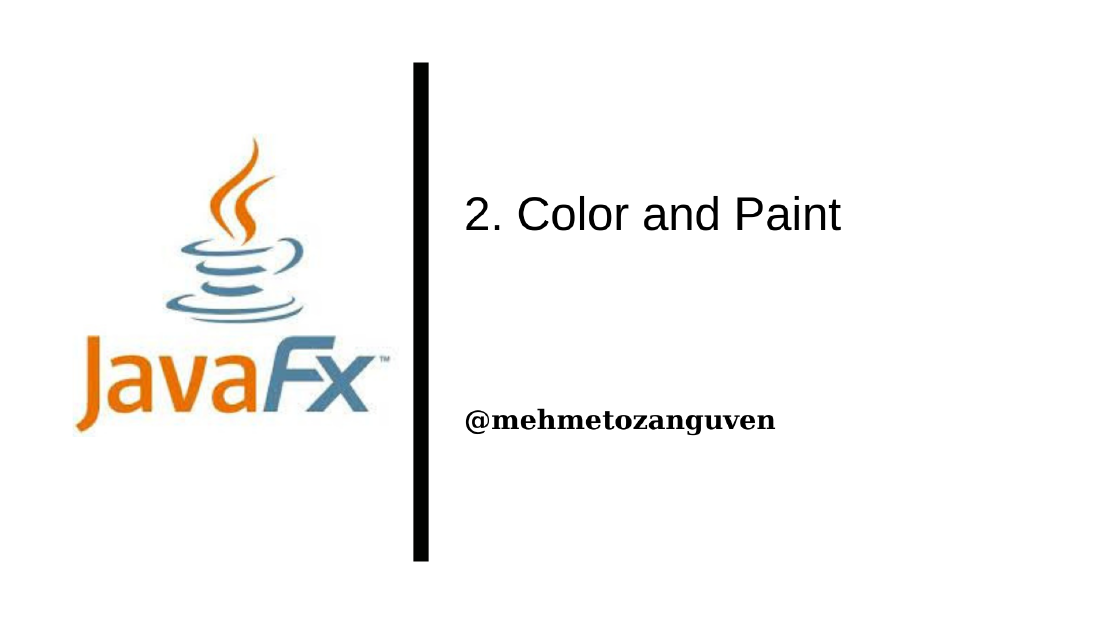
JavaFX Getting Started
GUI programs are different from the traditional program that you have encountered. GUI programs are event-driven which means that these programs …

Computer color uses an RGB color system which means that color on the a computer screen is specified by three numbers called color components, giving the level of red, green and blue in the color
In JavaFX, color is represented by type of Color class (from package javafx.scene.paint). And each color component is a double value in the range 0.0 and 1.0
Color object also has fourth component in the range 0.0 to 1.0, referred as the alpha color component used to represent the transparency or opaqueness of the color.
To create color object:
Color color = new Color(r, g, b, a);
// Or use factory method
Color color = Color.color( r, g, b, a );
You should use the factory method. In that way you can use the same objects for the same color (there is no reason to create new objects for the same color).
Also color objects are immutable, which means there is no way to change a color after it has been constructed.
If your computer uses 32 bit color, it means that the color of each pixel is actually represented using just 8 bits for each of the four color components. Eight bits can take integers from 0 to 255. So computer colors have traditionally been specified using integer color components in the range 0 to 255. JavaFX has a static method to create a color within the range 0 to 255
Color.rgb(r, g, b);
Color.rgb(r, g, b, a);// where r, g, and b are integers in the range 0 to 255.
// alpha color component(a) is a double in the range 0.0 to 1.0
An alternative to RGB is the HSB color system
IN HSB, a color is represented by three numbers called the hue, saturation and brightness.
To create a color from HSB
Color hsbColor = Color.hsb(h, s, b);
Color hsbColor = Color.hsb(h, s, b, a);
Color is a subclass of Paint which is a base class for a color or gradients used to fill shapes and backgrounds when rendering the scene graph. We can talk about Paint later on …
A font represents a size and style of text.
In JavaFX we have object for the fonts called Font.
We can create font object by using its static factory methods.
If system can’t find the given font name, it will try to match the best one it finds. If you want to match with the system font size, you can pass as null for the font name
In general we can create font in JavaFX:
Font fontCreation = Font.font(family, weight, posture, size);
/*
- Family is a String which specifies a font family such as "Times New Roman"
- weight is the enumerated type such as FontWeight.BOLD, FontWeight.NORMAL
- posture is also the enumerated type such as FontPosture.ITALIC, FontPosture.REGULAR
*/
Font font1 = Font.font(23);
Font font2 = Font.font("Times New Roman", FontWeight.BOLD, 14);
Font font3 = Font.font(null, FontWeight.BOLD, FontPosture.REGULAR, 44);
We can use Image object to show “image” in the JavaFX program. For instance, we can load image from the resources folder.
Image test = new Image("test.png");
The image can be displayed in a GraphicsContext
Image object to show “image” in the JavaFX program.
GraphicsContext
GUI programs are different from the traditional program that you have encountered. GUI programs are event-driven which means that these programs …
In distributed systems, we generally face the challenge of keeping our databases and external systems in sync. For instance when we create an order we …